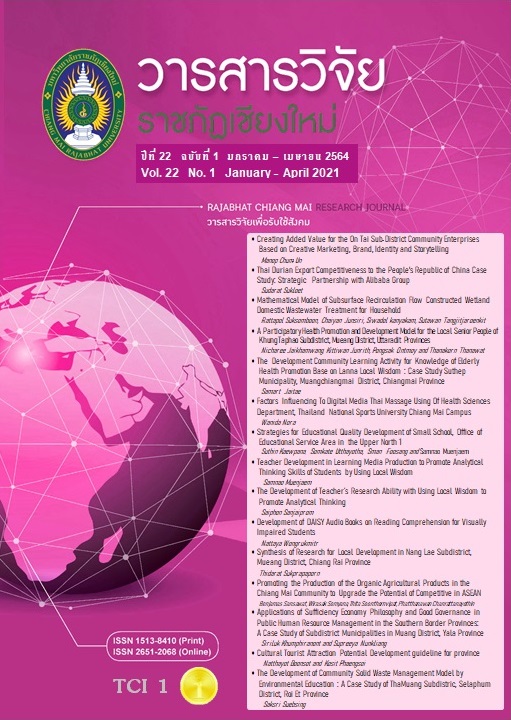Synthesis of Research for Local Development in Nang Lae Subdistrict, Mueang District, Chiang Rai Province
DOI:
https://doi.org/10.14456/rcmrj.2021.224136Keywords:
Synthesis, Nang Lae subdistrict, Chiang Rai provinceAbstract
The purposes of this study were to study synthesize research for local development in Nang Lae Subdistrict, Mueang District, Chiang Rai Province. The population is the dissertation of professors, researchers, master and doctoral students from 2007 to 2017 contents related to research for local development in Nang Lae Subdistrict, Mueang District, Chiang Rai Province. The researcher collects data by research team and creating a record information form using the synthesize research with qualitative data analysis. Data analysis was used in content analysis. To summarize a cognitive of strategy at Nang Lae Subdistrict. The study demonstrates as followings;
1) It was found that most of the research that brought change was female was personal research, Chiang Rai Rajabhat University was in 2015 in business administration and humanities and social sciences without research hypothesis, population research used questionnaire as research tools, specifying methods for finding tools Quality used basic statistics in data analysis, data analysis and survey for economic development and tourism.
2) The research found that the local development in Nang Lae Subdistrict, Mueang District, Chiang Rai Province. The results of the analysis of guidelines for local development in Nanglae Subdistrict Chiang Rai. According to the Strategy of the local government Organization, consisting of strategies, consisting of : Strategies for educational development, Strategy for the development of quality of life, Strategies for economic development and tourism, Strategies for the development of infrastructure and public utilities, Strategy on natural resources and the environment, Strategies for urban development and good management.
Downloads
References
Gordon, T.J. , (1994). Cross-Impact Method. Retrieved from http://www.acunu.org/millennium/applic-appb.htm
Nang Lae Sub-district Municipality (2015). Strategic Plan for the Development of Nang Lae Subdistrict Municipality 2015-2018. Chiang Rai: Nang Lae Subdistrict Municipality. (In Thai)
Panchan, P. (2009). Applying Cross-Impact Analysis Techniques to Study Guidelines for the Development of Negative Effects in English-based Curriculum in Schools under the Office of the Basic Education Commission in Bangkok. (Master of Education Thesis Education research disciplines, Department of Educational Research and Psychology, Faculty of Education, Chulalongkorn University). (In Thai)
Pedamallu, C. S., Ozdamar, L., Weber, G. W., & Kropat, E. (2010). A System Dynamics Model to Study the Importance of Infrastructure Facilities on Quality of Primary Education System in Developing Countries. AIP Conference Proceedings. https://doi.org/10.1063/1.3459767
Samuttai, R. (2011). Research synthesis and application of research results to study development. Teaching materials Faculty of Education Chiang Mai University. (In Thai)
Sittikan, B. (2010). Needs of tourists for community-based tourism management in Nang Lae Sub-district Municipality, Muang District, Chiang Rai Province. Chiang Rai: Mae Fah Luang University. (In Thai)
Tangchuang, P., Phuvipadawat, S., Kumsiripiman, K., Sinsuwan, P., & Kuenpetch G. (2005). A research synthesis funded income budget, Faculty of Education, Chiang Mai University in the academic year 1999-2002. Chiang Mai: Faculty of Education, Chiang Mai University. (In Thai)
Wiratchai, N. (1999). Meta-Analysis Meta-Analysis. Bangkok: Chulalongkorn University. (In Thai)
Downloads
Published
How to Cite
Issue
Section
License
1. Articles, information, content, images, etc published in the “Community and Social Development Journal” are copyrighted by the Community and Social Development Journal, Chiang Mai Rajabhat University. In order to properly distribute the articles through print and electronic media, the authors still hold the copyright for the published articles under the Creative Commons Attribution (CC BY) license, which allows the re-distribution of the articles in other sources. References must be made to the articles in the journal. The authors are responsible for requesting permission to reproduce copyrighted content from other sources.
2. The content of the articles appearing in the journal is the direct responsibility of the article authors. The editorial board of the journal does not necessarily agree with or share any responsibility.














